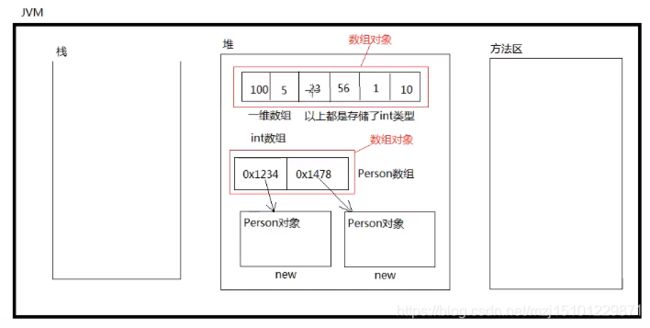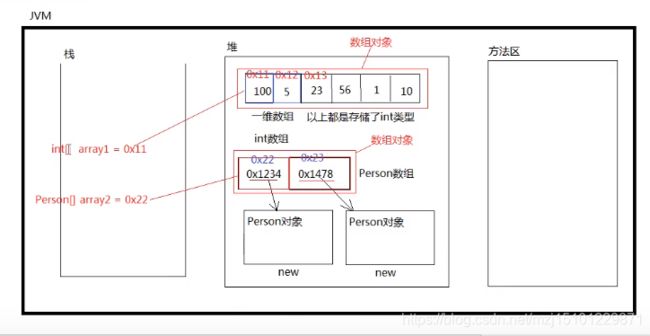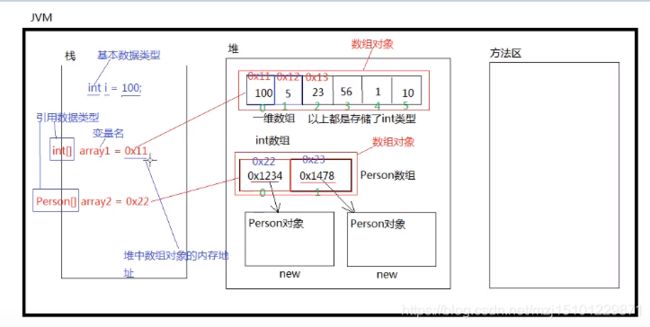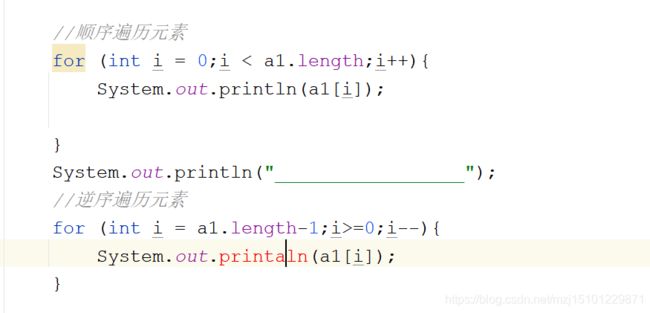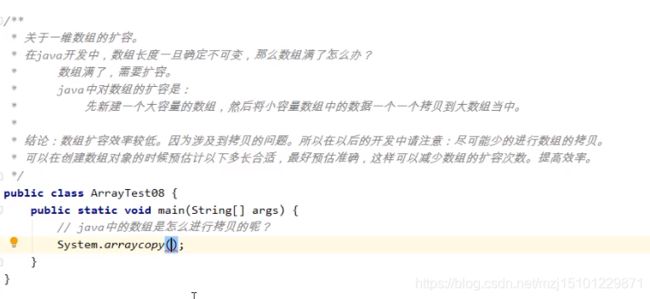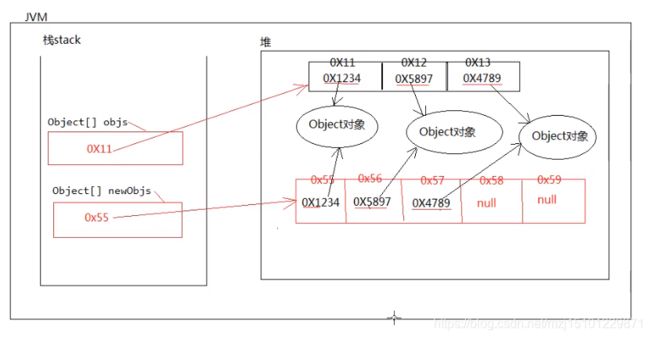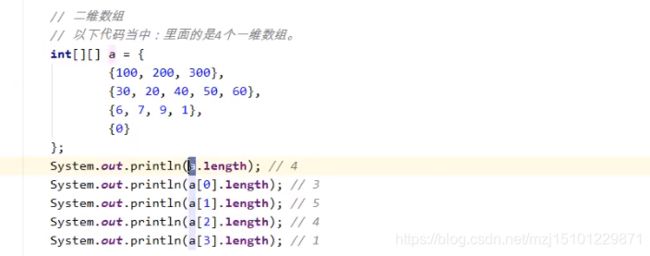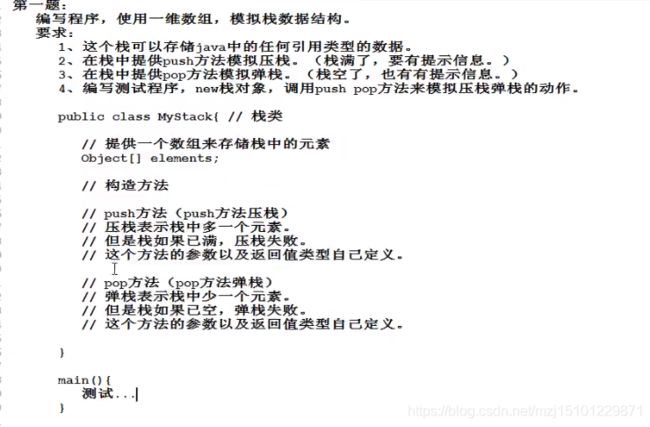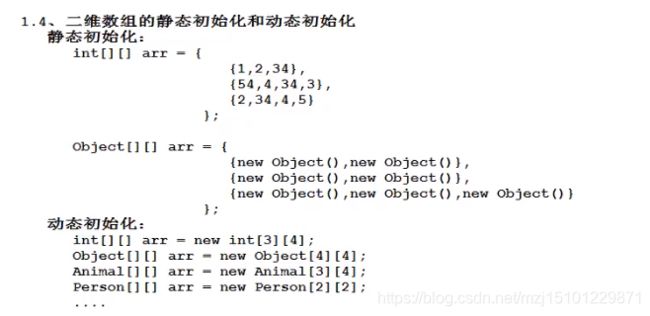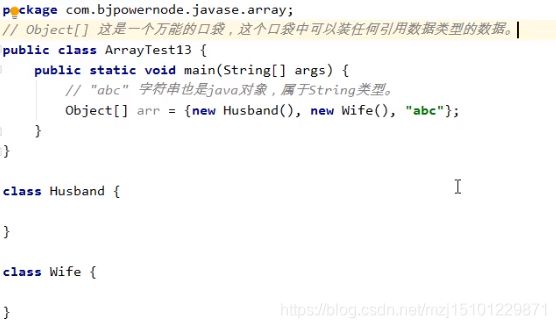java基础语法-day23进阶数组
p543 一维数组概述
/**
* 1、java语言中的数组是一种引用数据类型,不属于基本数据类型。数组的父类是Object
* 2、数组实际上是一个容器,存储多个元素。(数组是一个数据的集合)
* 3、数组可以存储基本数据类型,也可以存储引用数据类型。
* 4、数组是引用数据累心给,所以在堆内存中存储
* 5、数组中如果存储java对象的话,实际上存储的是java对象的引用。
* 6、数组一旦创建,在Java中规定,长度不可变
*
*
*/
P544-P546 一维数组内存结构以及优缺点
/**
* 1、java语言中的数组是一种引用数据类型,不属于基本数据类型。数组的父类是Object
* 2、数组实际上是一个容器,存储多个元素。(数组是一个数据的集合)
* 3、数组可以存储基本数据类型,也可以存储引用数据类型。
* 4、数组是引用数据累心给,所以在堆内存中存储
* 5、数组中如果存储java对象的话,实际上存储的是java对象的引用。
* 6、数组一旦创建,在Java中规定,长度不可变
* 7、数组分类:一维数组、二维数组、三维数组。
* 8、所有数组都有length属性用来获取数组长度
* 9、java中的数组要求元素类型统一。int类型数组只能存储int数据
* 11、将首元素的内存地址作为整个数组的内存地址(数组的内存地址就是第一个元素的内存地址)
* 12、每一个元素都有下标,下标从0开始,以1递增,最后一个元素的下标是length-1.数组的下标很重要,存取的时候需要通过下标来进行。
* 13、数组的优点:
* ·查找效率高(原因:1、每一个元素的内存地址在空间存储上是连续的
* 2、每一个元素类型相同,所以占用空间大小一样
* 3、知道第一个元素的内存地址,知道每一个元素占用的空间大小,
* 又知道下标。就可以通过计算得到)
* 13、数组的优点:
* ·查找效率高(原因:1、每一个元素的内存地址在空间存储上是连续的
* 2、每一个元素类型相同,所以占用空间大小一样
* 3、知道第一个元素的内存地址,知道每一个元素占用的空间大小,
* 又知道下标。就可以通过计算得到)
* 14、数组的缺点:
* ·第一:由于要保证空间连续,所以在数组上随机删除或增加元素时,
* 效率低,因为随即增删会导致后面元素的统一位移操作。
* ·第二:数组不能存储大数据量,为什么?
* 因为在内存空间上很难找到一块特别大的连续的内存空间。
*/
P547 初始化一维数组
* 15、定义一个数组:
* ·语法格式:
* int[] array1;
* double[] array2;
* boolean[] array3;
* ...
* 16、初始化一个一维数组语法格式:
* ·静态初始化:
* int[] array = {100,2100,300,4225};
* ·动态初始化:
* int[] array = new int[5];//初始化一个5个元素的int数组,每个元素默认值为0;
* String[] names = new String[6];//初始化一个6个元素的String数组,每个元素的默认值为null
*
P548 访问一维数组的元素
public class ArrayTest01 {
public static void main(String[] args) {
int[] a1 = {1,2,33,45,334,56,23};
System.out.println("数组中元素的个数:"+a1.length);
System.out.println("数组中第一个元素:"+a1[0]);
System.out.println("数组中第二个元素:"+a1[1]);
System.out.println("数组中第三个元素:"+a1[2]);
System.out.println("最后一个元素是:"+a1[a1.length-1]);
//修改元素
a1[0] = 111;
a1[a1.length-1] = 100;
System.out.println("数组中第一个元素:"+a1[0]);
System.out.println("最后一个元素是:"+a1[a1.length-1]);
}
}
P549 遍历一维数组
P550 动态初始化一维数组
public class ArrayTest02 {
public static void main(String[] args) {
//存储Object,采用静态初始化
Object o1 = new Object();
Object o2 = new Object();
Object o3 = new Object();
Object o4 = new Object();
Object[] objects = {o1,o2,o3,o4};
for (int i = 0; i < objects.length; i++) {
System.out.println(objects[i]);
}
System.out.println("++++++++++++++++++++++");
//采用动态初始化。
Object[] objects1 = new Object[4];
for (int i = 0; i < objects.length; i++) {
System.out.println(objects1[i]);
}
}
}
P551-p552 方法的参数是数组
public class ArrayTest03 {
public static void main(String[] args) {
int[] x = {1,2,3,4};
printArray(x);//调用方法的时候传递的参数是一个数组
String[] strs = {"abc","def","xyz"};
printArray(strs);
String[] strArray = new String[10];
printArray(strArray);
System.out.println("=================");
printArray(new int[3]);
printArray(new String[4]);
}
public static void printArray(int[] array) {
for (int i = 0; i < array.length; i++) {
System.out.println(array[i]);
}
}
//构造方法
public static void printArray(String[] array) {
for (int i = 0; i < array.length; i++) {
System.out.println("String数组中的元素:"+array[i]);
}
}
}
P553 -P554main方法中的String数组有什么用
public static void main(String[] args) 当中的String数组用来接收用户输入

public class ArrayTest06 {
//用户名和密码存储到String args数组中,所以数组的长度为2,
public static void main(String[] args) {
if (args.length != 2){
System.out.println("使用该系统时请输入程序参数," +
"参数包括用户名和密码信息," +
"例如:zhangsan,1234456");
return;
}
//程序执行到此处说明的确提供了用户名和密码
//接下来就应该判断用户名和密码
//取出过用户名和密码
//假设用户名和密码分别是admin和123就是登陆成功
String username = args[0];
String password = args[1];
/* if (username.equals("admin") && password.equals("123")) {
System.out.println("登陆成功,欢迎" + args[0] + "回来");
System.out.println("您可以使用该系统....");
} else {
System.out.println("验证错误,用户名不存在或者密码错误!");
}*/
//这样写if语句可以避免空指针异常
if ("admin".equals(username) && "123".equals(password)) {
System.out.println("登陆成功,欢迎" + args[0] + "回来");
System.out.println("您可以使用该系统....");
} else {
System.out.println("验证错误,用户名不存在或者密码错误!");
}
}
}
P555 引用数据类型的数组
public class ArrayTest07 {
public static void main(String[] args) {
Animal a1 = new Animal();
Animal a2 = new Animal();
Animal[] animals = {a1,a2};
//遍历,Animal类型的数组,每一次循环取出的元素就是Animal类型
for (int i = 0; i < animals.length; i++) {
/* Animal a = animals[i];
a.move();*/
animals[i].move();
}
System.out.println("======================");
Animal[] ans = new Animal[2];
ans[0] = new Animal();
// ans[0] = new Product();//报错
ans[1] = new Cat();
for (int i = 0; i < ans.length; i++) {
ans[i].move();
}
System.out.println("======================");
//创建一个Animal类型的数组,数组中存储Cat和Bird
Animal[] ans2 = new Animal[3];
ans2[0] = new Cat();
ans2[1] = new Bird();
ans2[2] = new Bird();
for (int i = 0; i < ans2.length; i++) {
// ans2[i].move();
//如果调用Animal的方法是没问题的,
// 但是如果调用子类的特有方法的话,就需要instanceof来判断
if(ans2[i] instanceof Cat){
// ((Cat) ans2[i]).catchMouse();//idea自动会强制转换
Cat cat = (Cat)ans2[i];
cat.catchMouse();
}else if (ans2[i] instanceof Bird){
Bird bird = (Bird)ans2[i];
bird.sing();
}
}
}
}
class Animal{
public void move(){
System.out.println("Animal move...");
}
}
class Product{
}
class Cat extends Animal{
public void move(){
System.out.println("猫在走猫步!");
}
public void catchMouse(){
System.out.println("猫在抓老鼠");
}
}
class Bird extends Animal{
public void move(){
System.out.println("Bird Fly!!!");
}
public void sing(){
System.out.println("鸟儿在歌唱!");
}
}
P556 -p557 数组的扩容、拷贝
public class ArrayTest08 {
public static void main(String[] args) {
int[] src = new int[5];
for (int i = 0; i < src.length; i++) {
src[i] = i;
System.out.println(src[i]);
}
System.out.println("==================");
//新建一个大数组用来拷贝,只拷贝2个元素
// int[] a2 = new int[10];
// System.arraycopy(a,1,a2,5,2);
// for (int i = 0; i < a2.length; i++) {
// System.out.println(a2[i]);
//
// }
//拷贝src中的所有元素到dest中
int[] dest =new int[20];
System.arraycopy(src,0,dest,0,src.length);
for (int i = 0; i < dest.length; i++) {
System.out.println(dest[i]);
}
System.out.println("=====================");
//拷贝引用数据类型
String[] strs1 = {"hello","world","baidu","jingDong"};
String[] strs2 = new String[20];
System.arraycopy(strs1,0,strs2,0,strs1.length);
for (int i = 0; i < strs2.length; i++) {
System.out.println(strs2[i]);
}
System.out.println("=====================");
Object[] objects = {new Object(),new Object(),new Object()};
Object[] newObjs = new Object[10];
System.arraycopy(objects,0,newObjs,0,objects.length);
for (int i = 0; i < newObjs.length; i++) {
System.out.println(newObjs[i]);
}
}
}
P556 二维数组
P558-p559 二维数组,二维数组的长度
P560 二维数组的元素访问
public class ArrayTest11 {
public static void main(String[] args) {
int[][] array = new int[3][4];
/* for (int i = 0; i < array.length; i++) {
for (int j = 0; j < array[i].length; j++) {
System.out.print(array[i][j]+" ");
}
System.out.println();
}*/
//静态初始化
int[][] a = {
{1,2,3,4},
{5,6,7},
{8,9},
};
printArray(a);
//可以这样写
printArray(new int[][]{{12,34,56},{67,78,89},{123}});
}
public static void printArray(int[][] array) {
for (int i = 0; i < array.length; i++) {
for (int j = 0; j < array[i].length; j++) {
System.out.print(array[i][j]+" ");
}
System.out.println();
}
}
}
